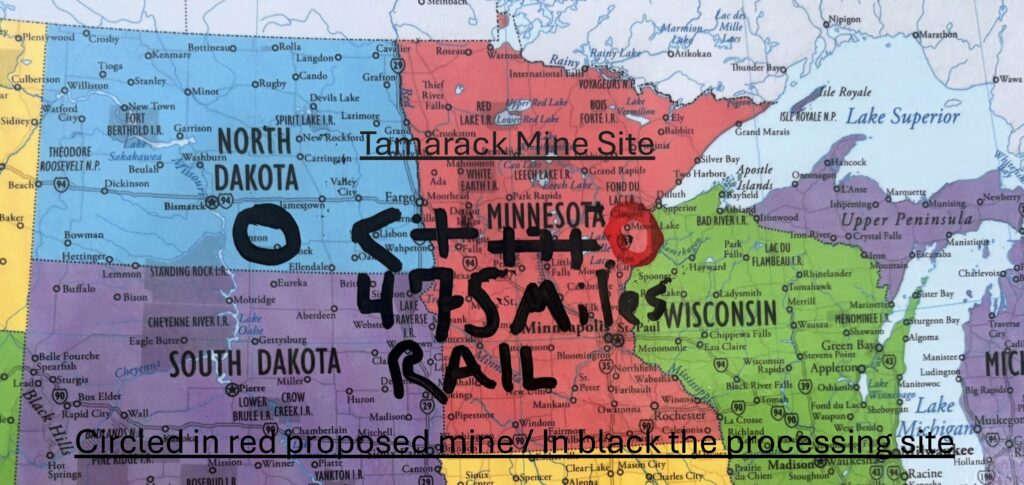The Tamarack Mine: Will It Be?
By JTC Energy Insights
Before the mine, before the power, before the rail—there is intent.
Tamarack begins where the grid gives out—deep in northern Minnesota, miles from the nearest substation, paved road, or rail spur. A cross-border partnership between Talon Metals (Canadian) and Rio Tinto (UK/Australian) is mapping a directional choreography: high-grade nickel extracted underground, concentrated on-site, and staged for a 475-mile rail sprint west to North Dakota. The destination is a repurposed 100-year-old coal site, slated for a new smelter facility—not yet constructed. The rail spur isn’t built either—but the route is literal. Tamarack holds one of the largest known high-grade nickel deposits in the United States.
No smelter. No infrastructure. No movement.
Just intent—mapped, directional, and deliberate.
The project is now undergoing its third state environmental review, part of a permitting process that stretches across multiple administrations. Talon began exploration at Tamarack in the early 2000s, but the current development push—anchored by the Talon–Rio Tinto partnership—is taking shape over the past five years. Even if approvals proceed, full-scale production isn’t imminent. Talon projects a ramp-up over the next decade, with commercial output not expected until the mid-2030s. This isn’t a ribbon-cutting—it’s a long-haul choreography, unfolding in regulatory time.
Unlike open-pit operations, Tamarack is designed as an underground mine—adding engineering complexity while minimizing surface disruption. The directional logic extends below ground: ore is extracted through narrow tunnels, concentrated on-site, and staged for outbound flow. This design reduces tailings, limits waste exposure, and shrinks the mine’s physical footprint. It’s not just a technical choice—it’s a mapped response to environmental scrutiny, tribal consultation, and the layered geology of northern Minnesota.
Tamarack’s planned power source—diesel—must be physically delivered. With no pipeline infrastructure and no active rail spur, fuel arrives by truck. That means staging from regional depots, navigating unpaved roads, and coordinating deliveries through northern Minnesota’s terrain. The mine’s remoteness turns diesel into a mapped input: every delivery must be timed, stored, and safeguarded against seasonal constraints. Diesel powers ventilation, drilling, and early infrastructure. Until grid access or on-site generation is built, Tamarack’s operations hinge on fuel routing. The inbound flow of diesel mirrors the outbound flow of nickel concentrate—each mapped, each deliberate.

The outbound choreography begins at Tamarack’s concentrate pad. Once processed underground, the nickel concentrate is staged for rail transport via a proposed 7-mile BNSF spur—new track that would connect the mine to the national rail grid. From there, it travels 475 miles west to the industrial heartland of North Dakota, where Talon has secured a 256-acre legacy coal site. That site is slated for transformation into a first-of-its-kind nickel processing facility, backed by a $114.8 million DOE grant. Neither the spur nor the 475-mile link is built yet—but the route is mapped. Power likely comes from the existing grid, potentially drawing from nearby coal-fired generation. This choreography shifts tailings and chemical processing away from Tamarack, repurposing an existing industrial footprint.
Tesla has committed to purchasing 75,000 metric tonnes of nickel concentrate from Tamarack over six years—roughly 165 million pounds. It’s a headline agreement, but not a full offtake. Tamarack’s projected output at full production is expected to exceed 300,000 metric tonnes over its initial mine life, which could span 50 years. No other buyers have been publicly confirmed. Talon retains the right to negotiate additional sales with Tesla, but the remaining nickel still needs a destination. Canada offers the most efficient option—existing smelters, shorter rail routes, and established processing capacity. But cross-border permitting, export logic, and U.S. domestic sourcing goals make that path unlikely. For now, the choreography ends in North Dakota. Beyond Tesla, the nickel’s future remains mapped only in intent.
Tamarack isn’t yet a domestic miner. It’s directional intent—unbuilt, under review. The U.S. nickel chain remains exposed: no active mining, no commercial-scale processing, and limited battery production. Tesla’s offtake covers only part of the output. Talon’s planned cathode facility in Michigan is still in permitting. Canada offers efficiency, but not alignment. For now, the choreography ends in North Dakota.
JTC continues mapping each stage—approval, construction, cathode flow. Eagle Mine in Michigan, the only active U.S. nickel source, follows in a separate write-up. Its choreography runs north—into Canada.
This is part of The Battery Trail: JTC’s legacy project tracing the physical choreography of metals, fuels, and infrastructure from mine to cathode. Not just supply chains—mapped authorship.
